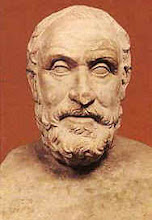 Today I would like to talk about Edwin Abbot Abbot’s famous 1884 science-fiction novel Flatland. This book is renowned for its criticism of Victorian society as well as for its explanation of abstract geometrical theories.
Today I would like to talk about Edwin Abbot Abbot’s famous 1884 science-fiction novel Flatland. This book is renowned for its criticism of Victorian society as well as for its explanation of abstract geometrical theories. The setting of Flatland is a two-dimensional world in which all of the “people” are geometric shapes moving around in a plane. The first half of the story explains the nature of Flatland and its society; the second half focuses on the main character’s encounter with a sphere.
Abbot begins with an explanation of what Flatland actually is. I will take a moment to do so as well, since it is very important to the story and to the points I am trying to make. Flatland is a two-dimensional plane, like a piece of paper. The inhabitants are two-dimensional polygons that move about the plane; they have no concept of the third dimension. A Flatlander can move in four perpendicular directions (north, south, east, west) and its field of vision is a line. No part of a Flatlander is three-dimensional; for example, a Flatlander’s “face” is not on its surface but on one of its sides.
Confused? Here’s a demonstration that will help: Put several coins on a table or desk and then bend down next to it so your eyes are level with the surface. See how the coins look like lines? This is how a two-dimensional being sees. Move the coins around a bit and try to visualize them as living beings, thinking about what they biological structure would have to be. (This is actually how Abbot explains it.)
The plot of Flatland is very simple; in the first half, Abbot explains what Flatland is (like I just did) and how its society functions. The second half is considerably more interesting; a Sphere visits the main character, A. Square, and tries to explain the idea of three dimensions to him. The Sphere first attempts to do so with words, notably with the phrase “Upward, not Northward” but A. Square simply cannot understand. To demonstrate, the Sphere pokes A. Square in his intestines, which he can reach by putting his finger into the Square insides from “above” (three dimensional above). However, A Square is still not convinced, so the Sphere knocks him out of his plane and drags him about outside of Flatland.
The duo then visit other societies that are defined by dimensionality: they first visit Lineland, in which the inhabitants are forever stuck next to the same people because they are in a line (one dimension). Next, they look at Pointland, which is inhabited by a single dimensionless being. Communication with it is impossible because the being is a solipsist; it believes everything it hears is its own thoughts, since it cannot move, see, or feel. A. Square then suggests that there could be more than three dimensions, since until recently he only knew of two. The Sphere dismisses this as nonsense, and sends A Square back to Flatland. A. Square later tries to teach others about the third dimension, but without the sphere he is incapable of doing so. Since he cannot show his peers the direction of “Upward, not Northward,” he is thrown in jail for heresy.

Flatland clearly satires Victorian society: Abbot goes into detail explaining a class system based around shape. The few sides a “person” has, the lower their rank; triangles are working class and are considered non-intelligent; polygons with many sides are priests or leaders. The king is a polygon with so many sides he is almost indistinguishable from a circle. Certain shapes can “evolve”—all shapes except triangles gain a side each generation, increasing their rank. The lower class triangles do not share this attribute; they are forced to first become equilateral triangles. However, they only progress at a rate of half a degree per generation—this obviously signifies the perpetual enslavement of the working class by the Victorian elites. Women in Flatland are straight lines, and they are forced to move in such a way that they constantly swing back and forth so they can be seen (remember that looking at a straight line in a certain way makes it look like a point, which is hard to see). This is also a parody of Victorian women, who were also “invisible” unless they made their presence known. Colors are banned in Flatland society, since lower classes could paint themselves to look like higher-class shapes.
But Flatland is better known for its explanation of dimensional theories of geometry. Abbot explains the theory of the fourth spatial dimension by analogy in the story, and certain plot events are actually methods for “studying” the fourth spatial dimension. Tomorrow, I will delve deeply into what the fourth spatial dimension actually is, some applications of it, and how it relates to Flatland.

4 comments:
Rest assured, tomorrow's post will astound and amaze you.
I want to visit Flatland.
You mean you want to be 2D or you want to visit as a 3D person? Either one would be a bit weird, but I'd prefer remaining 3D. Being 2D would not be much fun.
I think I would want to stay in 3D too. Flatland sounds too weird for me...
But don't worry Billy! I'm reading the rest of them.
(not that i'll understand them)
Post a Comment